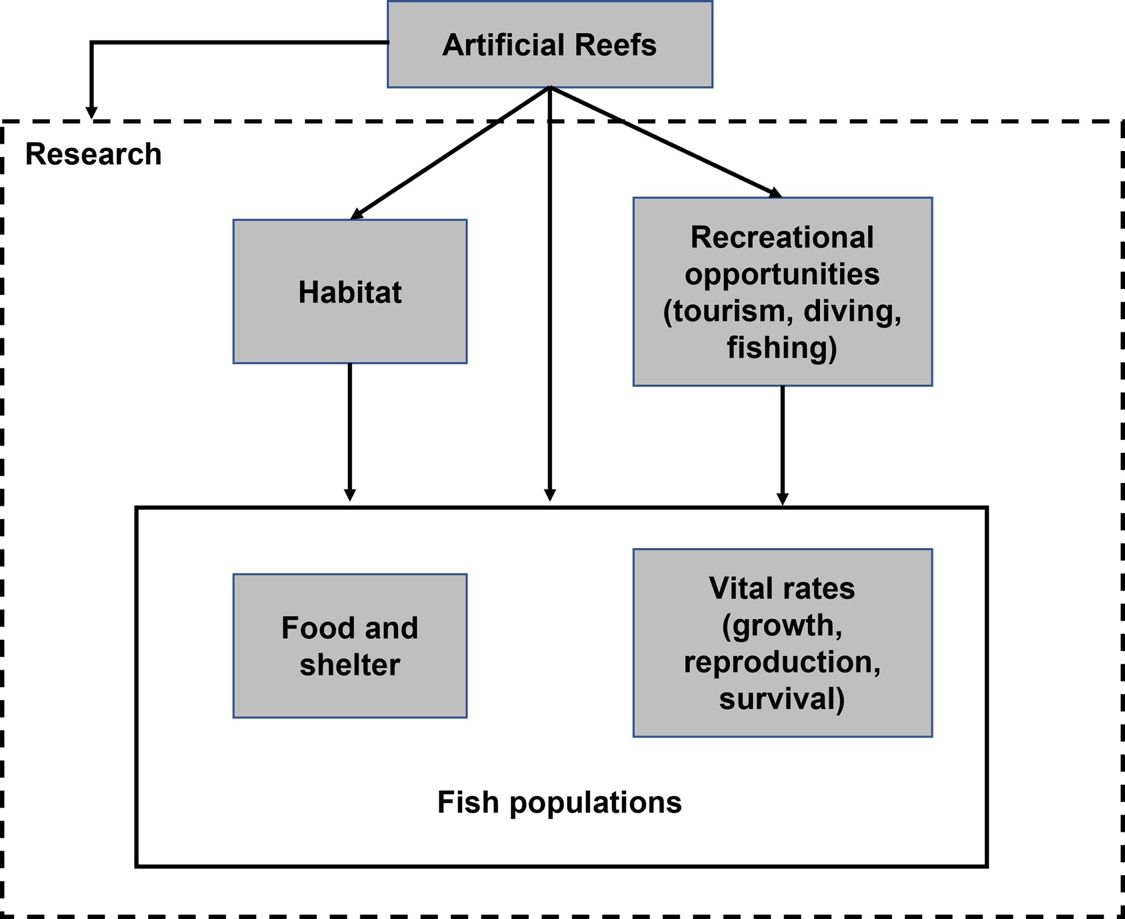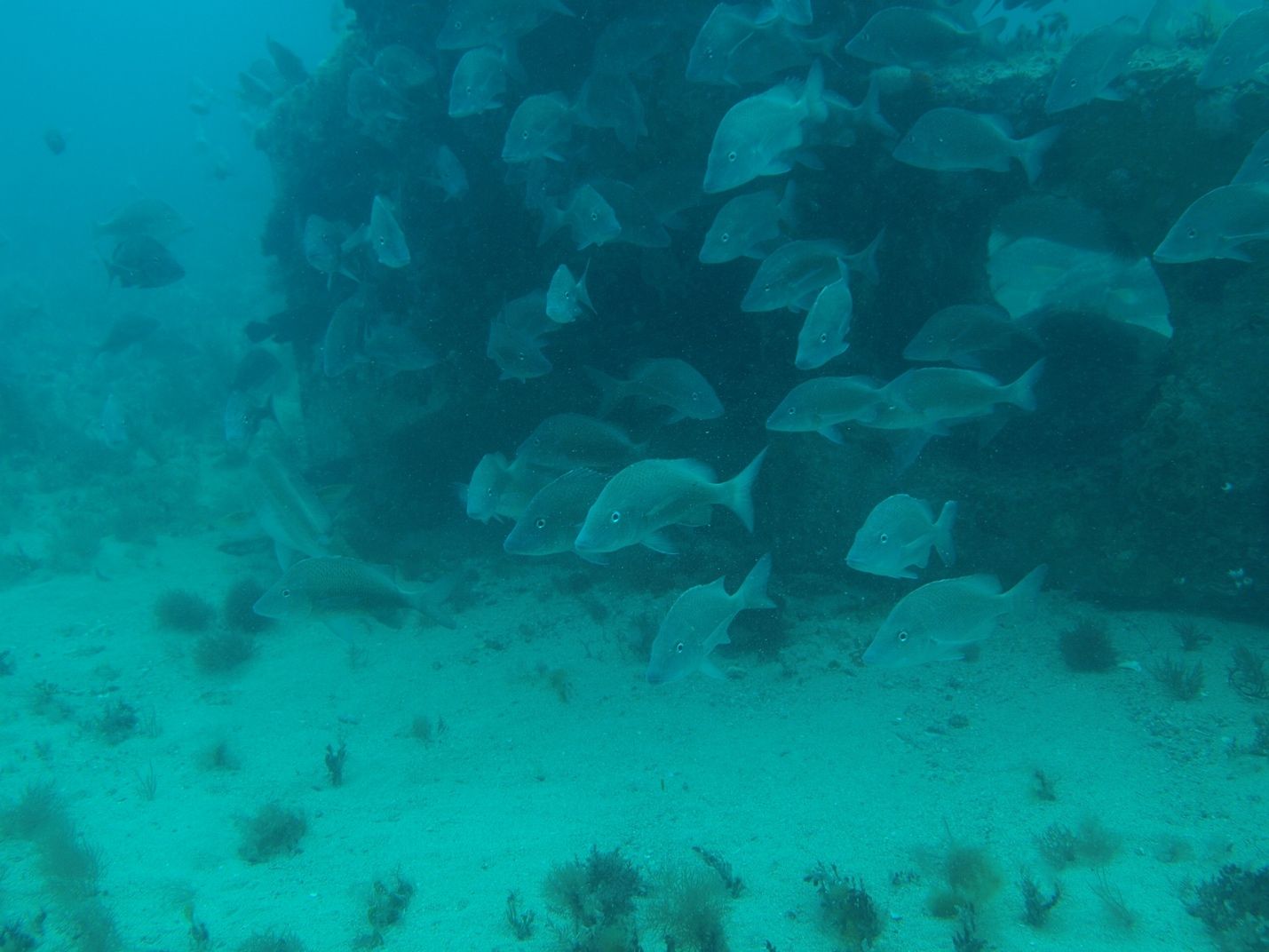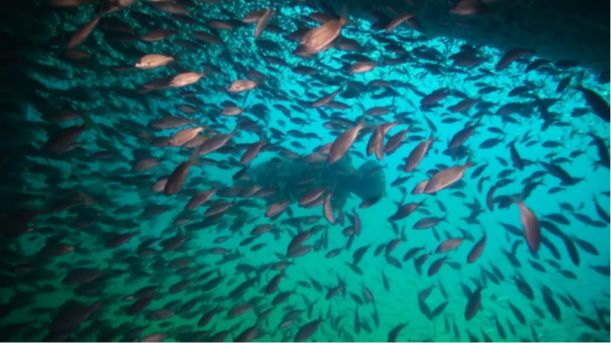Artificial Reefs in Florida 101—why this series?
Increasingly, coastal managers and practitioners are placing artificial reefs in marine waters. Artificial reefs are expensive to deploy, but they are much more expensive to remove. This makes them relatively permanent habitat alterations. These long-lasting habitat alterations have measurable effects on fish, fishers, divers, fisheries, and the overall marine ecosystem and connected human socioeconomic system. To make good decisions about future artificial reefs, it is critical to understand how artificial reefs “work.” There is scientific research on many aspects of artificial reefs, but this information is not always summarized and explained. In response to this need, we designed a 4-part series called Artificial Reefs 101:
- Part 1 describes why artificial reefs are built in the first place.
- Part 2 describes how artificial reefs affect fish ecology.
- Part 3 describes how artificial reefs affect users, mostly focusing on fishers.
- Part 4 describes how the overall fishery system (both fish and fishers) is affected by artificial reefs.
The Artificial Reefs 101 series is intended to provide a general overview for users seeking to better understand artificial reefs in Florida. It will also give additional background material for those wishing to dive deeper into the specifics. The Artificial Reefs 101 series complements existing publications about specific aspects of artificial reefs, such as how they are implemented (FA231), the ecological effects of artificial reefs on fish (SG100), and the economic benefits of artificial reefs (FE649). Additional information is available through the Florida Master Naturalist Program in the Marine Habitat Restoration Course.
This specific publication, Part 1 of the series, explains why artificial reefs are built. It first describes and defines what artificial reefs are. Then, it explores some of the main reasons that people build and deploy artificial reefs. This publication should help the interested public understand more about the ways artificial reefs affect marine resources. It will also provide a background and baseline of information for decision-makers such as local officials, management agency personnel, and Extension agents.
What are artificial reefs?
Artificial reefs are underwater structures placed on the sea floor with the intention of increasing marine life (Seaman and Jensen 2000). Artificial reefs are built for several reasons, including protecting and improving habitat, increasing populations of fish and other marine life, enhancing fishing and diving opportunities, and improving scientific research. These reasons are shown in Figure 1. Artificial reefs usually consist of durable materials like concrete, limestone, steel, rocks, or other materials (Figure 2). Some well-known artificial reefs are made from objects that were built for other purposes, such as decommissioned military equipment or sunken ships. Many recent artificial reefs are called reef modules and are built specifically for this purpose. Regardless of how they are built, artificial reefs are increasingly common around the world and in Florida.

Credit: Lisa Chong

Credit: Michael Dickson, UF/IFAS Extension Florida Sea Grant
Why are artificial reefs built?
Protecting and Improving Habitats
Habitat loss and changes of marine environments have widespread impacts on marine life. Important ecosystems, such as coral reefs and seagrasses, are declining throughout the world. Coastal managers and restoration experts often construct artificial reefs in an attempt to protect, restore, or supplement these habitats. Some artificial reefs are strategically placed to draw fishing and diving pressure away from sensitive natural habitats. In other cases, artificial reefs can serve to protect coastlines and beaches by buffering wave action and reducing storm damage (Harris 2009). In Florida, some reefs are deployed specifically to help protect coral and natural hard bottom habitat, especially in popular recreational diving areas.
Fish Populations
Probably the most common reason, in Florida and globally, for building artificial reefs is to increase fish populations or improve fishing (Figure 3). However, it is challenging to understand how well artificial reefs accomplish this. There are relatively few studies clearly quantifying positive or negative impacts of artificial reefs on overall fish populations (Fabi et al. 2011). This results in a lack of agreement among the scientific community about how artificial reefs affect fish populations. This argument has often been called the “attraction vs. production” debate (Lindberg 1997). To understand the ideas, we will imagine a new artificial reef. A year after our model reef is built, it has schools of fish of multiple different species around it. The attraction vs. production debate asks the question, “Why are those fish on this new reef?” Maybe these fish were produced by the reef and would not have survived at all without it. Or perhaps the fish on this new reef were simply attracted from other areas of the ocean and would exist somewhere else without the new reef. The answer probably depends not only on what species of fish are frequenting the reef and on what type of reef it is, but also on what other alternative habitat exists. The complicated truth is that artificial reefs probably produce a combination of those effects, and whether they produce or attract more depends on the details. Studies show that artificial reefs support other marine life like algae and invertebrates around the reefs. These are consumed by many fish (Wall and Stallings 2018). Some fish species are even known to “recruit” to artificial reefs and use them as nursery habitat. At the same time, other studies show artificial reefs clearly attract larger fishes (e.g., jacks, tuna, sharks; Simon et al. 2011). Regardless of how many fish are “attracted” versus “produced,” artificial reefs are likely to affect fish vital rates, which are factors that affect population numbers, such as growth, reproduction, and survival. More on how artificial reefs impact fish and these vital rates can be found in part two of this artificial reef series.

Credit: Angela Collins
Increasing Biodiversity
In addition to increasing local abundance of certain species, artificial reefs are also built to increase the diversity of species in an area. Reef-dwelling organisms, like microbes, algae, invertebrates, and fish, contribute to the biodiversity in an ecosystem. Biodiversity is the variety of life across marine ecosystems. Biodiversity is high if there are more types of organisms. These organisms create reef communities that can provide food resources for many species at different trophic levels in the food web. Artificial reefs were shown to increase marine biodiversity in bare-bottom areas that do not naturally have structure like coral or rocky reefs (Heery et al. 2017). They do this by providing hard surfaces on which algae, other plants, and invertebrates (like corals, mollusks, or crustaceans) can attach. These species provide food for consumers. Several marine organisms also live in various habitats throughout their lives. For example, some young fish live in mangroves and seagrass beds and then later move to deeper water habitats like coral reefs or natural hard bottom as they grow older (Kimirei et al. 2013). For species like these, artificial reefs may function as adult or sub-adult habitat, or they may serve as “stopping places” that provide shelter as fish move between seagrass, mangroves, and other estuarine habitats and open water habitats.
Fishing, Diving, and Tourism Opportunities
One of the main reasons people want to increase the number and types of fish populations is so they can catch them (fishing) or see them (diving). Artificial reefs are generally very popular with recreational fishers and divers. There are several reasons for this. On the fishing side, artificial reefs often have a lot of fish around them (from attraction, production, or both). Artificial reefs are usually easy to find because the coordinates for most of them are publicly available. In Florida, the Florida Fish and Wildlife Conservation Commission (FWC) maintains artificial reef location information here. From the diving perspective, artificial reefs can increase recreational opportunities by providing interesting underwater areas to explore, observe marine life, and even offer art or memorial displays (Sutton and Bushnell 2007). There are many popular wreck diving sites throughout the world. Ships are often sunk as artificial reefs to attract divers. In Florida, the USS Spiegel Grove in the Florida Keys and USS Oriskany in the Florida Panhandle are decommissioned military vessels that attract thousands of divers annually. Fishers and divers who use artificial reefs can stimulate the local economy, especially when they travel from other areas. For this reason, artificial reefs are often considered important for tourism-based economies (Ropicki et al. 2021) and are often supported by local (county) governments (Lindberg 1997).
Research Opportunities
It is less common for artificial reefs to be built specifically for research, but it does occur. Efforts in this area continue to increase as natural habitat degradation becomes more widespread. Research conducted on artificial reefs can help fisheries scientists, ecologists, and biologists learn about how habitat change affects marine ecosystems. Artificial reef research in past decades has focused more on the biology and ecology of reef fish, such as how they spawn or recruit to habitats (e.g., Lowry et al. 2014). Information from these studies not only helps scientists better understand the effects of artificial reefs, but it can also help them learn about how changes to natural habitat, like coral reefs, might affect ecosystems. In recent years, scientists have started to study how artificial reefs affect both fish and fishers, particularly how human activities affect fish behaviors (like movement or aggregations). Scientists think that these interactions could depend on the design and location of artificial reefs as well as the fish species and their life histories. Sometimes, artificial reef research combines ecology with fisheries. For example, scientists from the University of Florida and FWC have developed the Steinhatchee Fisheries Management Area (SFMA) to deploy artificial reefs solely as research tools. These reefs are used to test gag grouper vital rates and how their population density affects habitat use (Lindberg et al. 2006). The SFMA is also used for testing to determine whether large-scale reefs can function as fisheries management tools.
Another ongoing research effort that involves human use of artificial reefs is the Florida State Reef Fish Survey (more information available here). This project targets recreational fishers who have the State Reef Fish Angler designation and asks them information about fishing trips, including visiting artificial reefs. Fishers’ answers will help the state understand how best to deploy these reefs in the future.
Finally, another component of recent artificial reef research focuses on coastal protection. Artificial reefs can protect beaches and sensitive coastal habitats (Mendoza et al. 2019) by decreasing wave energy (Harris 2019). While fewer artificial reefs in Florida are implemented for these reasons, this may change in the future.
Summary
Artificial reefs are usually implemented to benefit humans by benefiting ecosystems. The most common objective for creating artificial reefs is to improve habitat for marine life, especially fish. The assumption is that these artificial habitats will at least be used by fish, and may even increase fish populations. How well artificial reefs gather and bolster fish populations determines how these structures can meet their ultimate goals of improving fishing and diving and increasing biodiversity. Beyond this, some artificial reefs are built specifically to help scientists and managers learn about how marine systems and socioeconomic systems are connected. Finally, artificial reefs are increasingly being built to protect valuable but vulnerable shorelines from erosion from waves and storms. It is important to understand that artificial reefs may not always do exactly what they were designed for. For example, some artificial reefs may not be used by the desired fish species but by invasive species. Or other reefs built to help scientists learn may turn into fantastic fishing locations, too. This means that understanding why artificial reefs are built is just the beginning—what we need to know is how they affect fish, fishers, and the entire marine ecosystem as well as the human socioeconomic system. This information is explored in the next few publications in this series.
References
Bortone, S. A., F. P. Brandini, G. Fabi, and S. Otake. 2011. Artificial Reefs in Fisheries Management. CRC Press, Taylor and Francis Group, Boca Raton, London, NY.
Harris, L. E. 2009. “Artificial Reefs for Ecosystem Restoration and Coastal Erosion Protection with Aquaculture and Recreational Amenities.” Reef Journal. 1 (1): 235–46.
Heery, E. C., M. J. Bishop, L. P. Critchley, A. B. Bugnot, L. Airoldi, M. Mayer-Pinto, E. V. Sheehan, R. A. Coleman, L. H. L. Loke, E. L. Johnston, V. Komyakova, R. L. Morris, E. M. A. Strain, L. A. Naylor, and K. A. Dafforn. 2017. “Identifying the Consequences of Ocean Sprawl for Sedimentary Habitats.” Journal of Experimental Marine Biology and Ecology 492:31–48. https://doi.org/10.1016/j.jembe.2017.01.020
Kimirei, I. A., I. Nagelkerken, M. Trommelen, P. Blankers, N. Van Hoytema, D. Hoeijmakers, C. M. Huijbers, Y. D. Mgaya, and A. Rypel. 2013. “What drives ontogenetic niche shifts of fishes in coral reef ecosystems?” Ecosystems 16 (5): 783–796. https://doi.org/10.1007/s10021-013-9645-4
Lindberg, W. J. 1997. “Can science resolve the attraction-production issue?” Fisheries 22:10–13.
Lindberg, W.J., T. K. Frazer, K. M. Portier, F. Vose, J. Loftin, D. J. Murie, D. M. Mason, B. Nagy, and M. K. Hart. 2006. “Density‐Dependent Habitat Selection and Performance by a Large Mobile Reef Fish.” Ecological Applications 16 (2): 731–46. https://doi.org/10.1890/1051-0761(2006)016[0731:DHSAPB]2.0.CO;2
Lowry, M. B., T. M. Glasby, and C. A. Boys. 2014. “Response of Fish Communities to the Deployment of Estuarine Artificial Reefs for Fisheries Enhancement.” Fisheries Management and Ecology 21:42–56. https://doi.org/10.1111/fme.12048
Mendoza, E., A. Ríos, I. Mariño-Tapia, and R. Silva. 2019. “Modular Coral Shaped Artificial Reefs Acting as Beach Protection Barriers.” Coastal Structures 989–997.
Simon, T., H. T. Pinheiro, and J. C. Joyeux. 2011. “Target Fishes on Artificial Reefs: Evidences of Impacts over Nearby Natural Environments.” Science of the Total Environment 409 (21): 4579–84. https://doi.org/10.1016/j.scitotenv.2011.07.057
Sutton, S. G., and S. L. Bushnell. 2007. “Socio-Economic Aspects of Artificial Reefs: Considerations for the Great Barrier Reef Marine Park.” Ocean and Coastal Management 50: 829–846. https://doi.org/10.1016/j.ocecoaman.2007.01.003
Ropicki, A., C. Adams, B. Lindberg, and J. Stevely. 2021. “The Economic Benefits Associated with Florida's Artificial Reefs.” FE649. EDIS 2021 (4): 8–8. https://doi.org/10.32473/edis-fe649-2021
Wall, K. R., and C. D. Stallings. 2018. “Subtropical Epibenthos Varies with Location, Reef Type, and Grazing Intensity.” Journal of Experimental Marine Biology and Ecology 509:54–65. https://doi.org/10.1016/j.jembe.2018.09.005